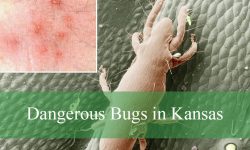Black and white ladybugs with striking monochromatic patterns have a unique appeal. There are more than 6,000 species of ladybugs in nature around the world. Black and white ladybugs are often misunderstood, mistakenly labeled as bad luck, or even toxic in folklore and superstition.
However, in reality, they are just as harmless and beneficial as their red or yellow counterparts. In agriculture, black and white ladybugs play an important role in maintaining ecological balance; they eat mildew and harmful aphids.
Different Black and White LadyBug Species
Psyllobora Bicongregata
![]()
Psyllobora bicongregata is a remarkable species of ladybugs known for its distinctive coloration. These ladybugs have an off-white color with brown and black spots. Their bodies are entirely white, but the dark spots are a combination of brown and black segments.
As the ladybugs mature, the coloration of their bodies changes. Initially, their bodies are pure white, then they turn cream, light brown, and finally settle into a dark brown color. This color transition occurs as they age.
This species of ladybug originates from South America and has been imported to various parts of the world. Psyllobora bicongregata is known not only for its unique appearance but also for its important role in biological control, helping to manage the populations of aphids and other pest insects. Thanks to their distinctive colors and patterns, these ladybugs can be easily recognized and distinguished from other ladybug species in the wild.
Globe-Marked Lady Beetle

Globe-marked Lady Beetles (Azya orbigera) are a distinct species of ladybugs recognized for their unique white fuzzy appearance with black undertones. One of their most striking features is the presence of two large black spots on their elytra. These ladybugs are relatively small, growing to a maximum size of only 3-5mm, making them one of the smaller species within the Coccinellidae family.
The larvae of Globe-marked Lady Beetles are also white and primarily feed on mildew, which makes them beneficial for natural pest control in environments where mildew is present. Their white and black coloration provides a good camouflage against predators, blending in with the mildew they inhabit and feed on.
The combination of their fuzzy white appearance, distinct black spots, and small size makes them easy to identify. This species is particularly useful in agriculture and gardening due to their diet and role in controlling mildew populations.
Psyllobora Picta
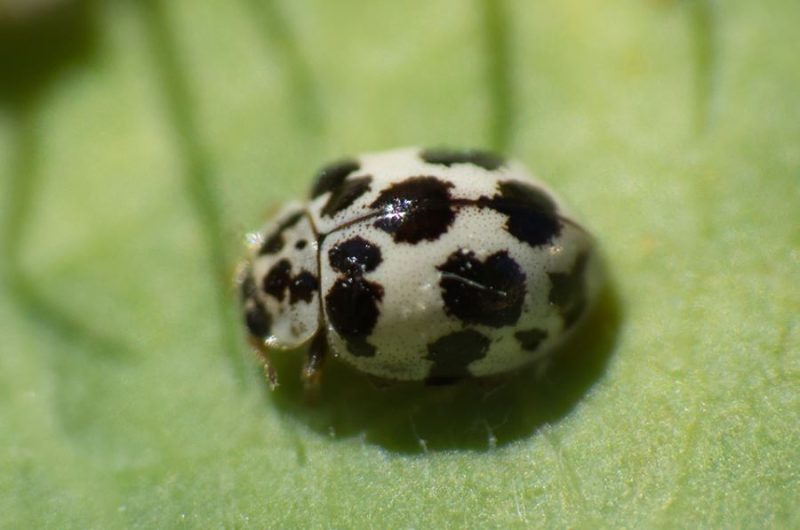
Psyllobora picta is a species of ladybug native to South America that is now increasingly observed across North America. This species is characterized by its white coloration with distinctive black spots, differing from many other ladybugs in that it does not feed on aphids. Instead, Psyllobora picta primarily consumes mildew, thriving on plants where mildew is present.
The physical appearance of Psyllobora picta includes a white head marked with large black spots and white elytra adorned with irregularly shaped black marks. Additionally, this ladybug species has yellow-orange legs and yellow-orange antennae, adding to its unique and easily identifiable look.
Psyllobora picta is relatively small, and its contrasting black and white markings, along with the striking yellow-orange appendages, make it easily recognizable. Its role in the ecosystem is significant as it helps control mildew populations, which can be beneficial for plants affected by this type of fungus.
Given its distinctive markings and coloration, as well as its ecological niche, Psyllobora picta stands out among ladybugs and is an important species for natural mildew management in gardens and agricultural settings.
Fifteen-Spotted Lady Beetle
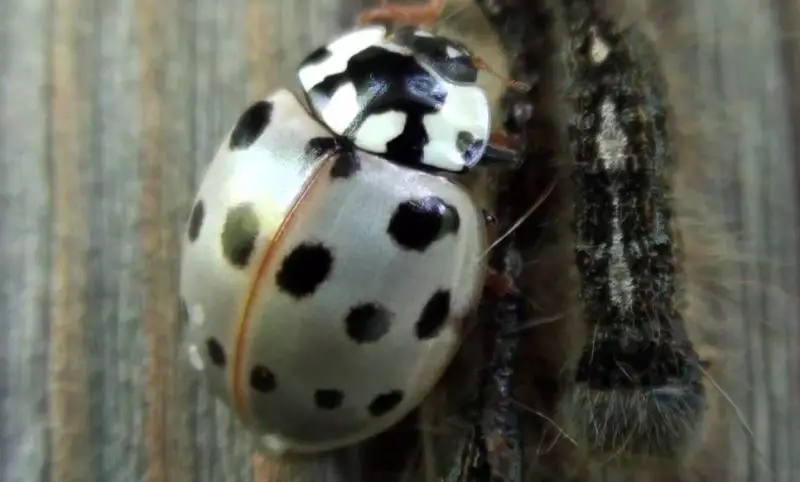
The Fifteen-spotted Lady Beetle (Anatis labiculata) is a distinct species native to North America, easily recognizable by its unique coloration and markings. This lady beetle features white elytra adorned with fifteen black spots, making it stand out among other lady beetle species. Its pronotum is also white and bears an M-shaped black mark, while the head is white with additional black markings.
The legs and the margins of the elytra are orange, adding to the beetle’s distinctive appearance. These physical characteristics make the Fifteen-spotted Lady Beetle relatively easy to identify in the wild.
These lady beetles inhabit areas where they can find small bugs to feed on, particularly aphids and mites. However, their diet is not limited to these insects; they also consume other types of smaller bugs, contributing significantly to the control of pest populations.
Twenty-Spotted Lady Beetle
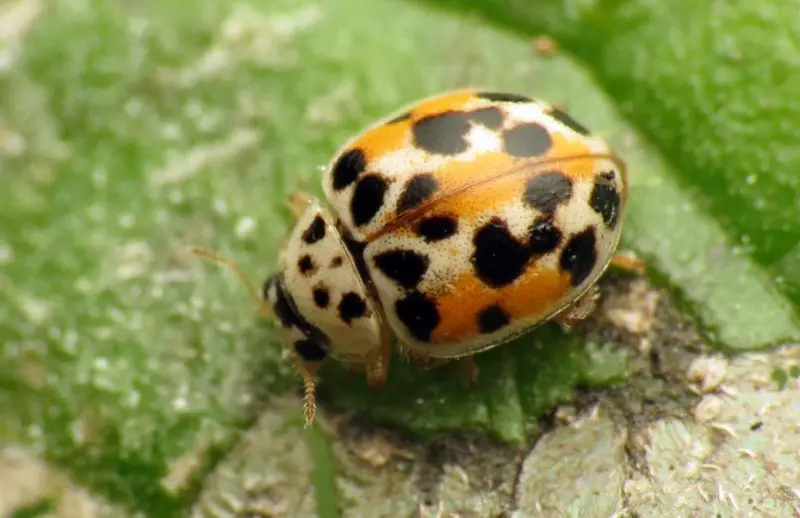
The Twenty-spotted Lady Beetle (Psyllobora vigintimaculata) is a unique species native to North America, easily identifiable by its distinctive coloration and patterning. This lady beetle features a white head, white pronotum, and white elytra, all adorned with numerous black spots. Interestingly, in some states, these beetles may exhibit orange spots instead of black.
This species is widespread across the United States, though notably absent from Florida. The Twenty-spotted Lady Beetle is primarily found on plants and crops affected by mildew, as mildew constitutes its exclusive diet. Unlike many other lady beetles that consume a variety of insects, the Twenty-spotted Lady Beetle is particularly selective, feeding only on mildew.
Their specialized diet makes them valuable for managing mildew in agricultural and garden settings. The beetle’s striking appearance, with its white body and contrasting spots, coupled with its ecological role, make it a recognizable and important species in North America.
Given their habitat preferences and unique dietary needs, the Twenty-spotted Lady Beetle can be found wherever mildew is present, contributing to the natural control of this common plant issue. Their distinctive coloration and specialized feeding habits make them a fascinating subject for both entomologists and gardeners alike.
Ashy Gray Lady Beetle
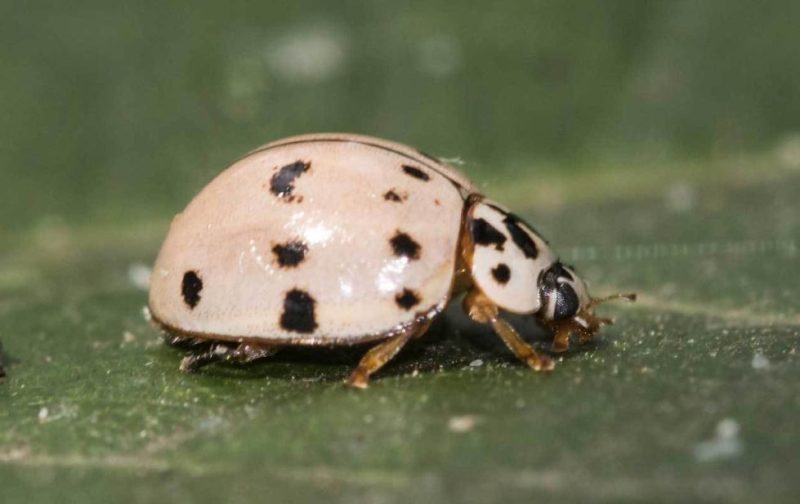
Ash Gray Lady Beetles (Olla v-nigrum) are a distinctive species notable for their two main color morphs: white and black. The white morph exhibits an off-white or white-gray coloration with small black spots scattered across the elytra and head. This morph’s bright coloration contrasts sharply with the black morph, which displays large red spots on the elytra.
These lady beetles are particularly beneficial in gardens, where they play a crucial role in controlling populations of invasive bugs. Female Ash Gray Lady Beetles lay yellow eggs, which are easily noticeable on the undersides of leaves and other sheltered areas.
Upon hatching, the larvae exhibit a striking black and yellow coloration, markedly different from the adult beetles. The larvae stage is an important part of their life cycle, contributing significantly to pest control as they feed voraciously on various harmful insects.
The contrasting morphs and life stages of the Ash Gray Lady Beetle make it a fascinating subject for observation. Its role in natural pest management, combined with its distinctive appearance, ensures that this beetle is a valuable and easily recognizable asset in any garden or agricultural setting.
Bulaea Lichatschovi
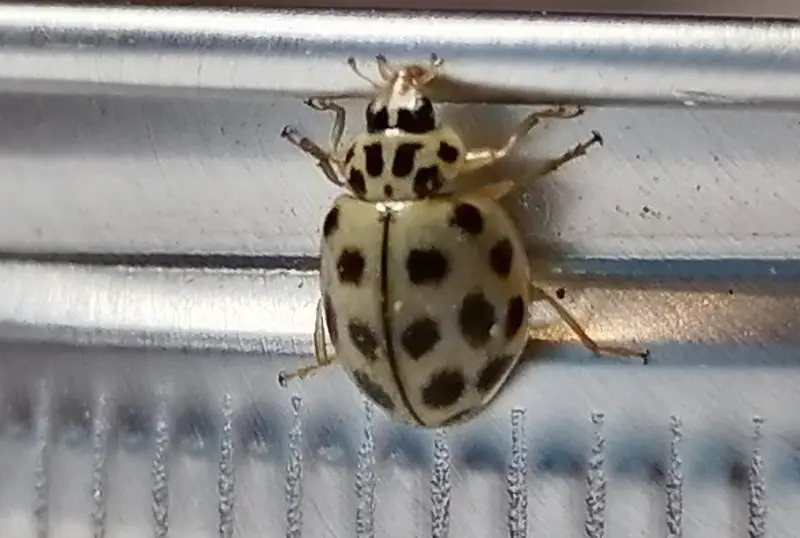
Bulaea lichatschovi, a ladybug species native to Southern Europe, is easily identifiable by its distinctive coloration and pattern. The beetle’s body is predominantly white or cream-colored, adorned with various black spots and marks. A notable feature is the large black spot on its head, accompanied by tan spots on the pronotum and multiple smaller black spots on the elytra. Additionally, a central black stripe runs along the elytra, further distinguishing this species from others.
The legs of Bulaea lichatschovi are yellow-brown or tan, adding to its unique appearance. This combination of white or cream base color with contrasting black and tan markings makes it a visually striking beetle.
Bulaea lichatschovi is typically found in regions where it can find its preferred food sources, playing a role in the local ecosystem by preying on smaller insects. Its distinct markings and coloration, along with its specific habitat preferences, make it an important species for study and observation in Southern Europe. The striking appearance and beneficial role of Bulaea lichatschovi in controlling pest populations highlight its ecological importance.
Epilachna Nigrocincta
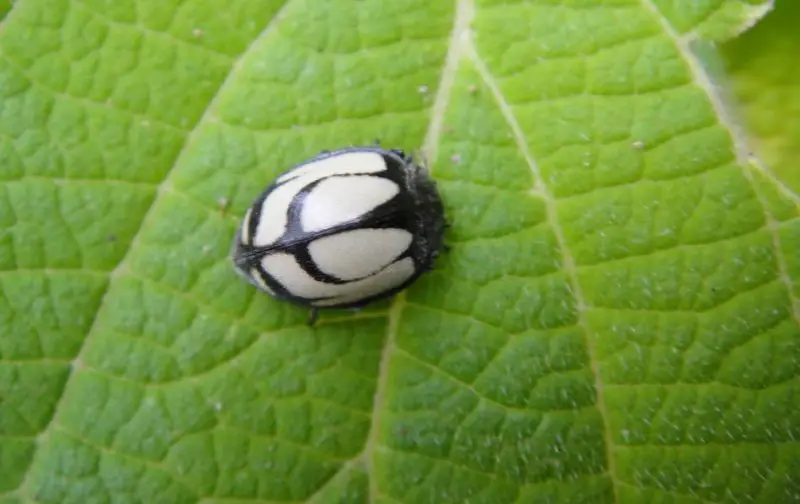
Epilachna nigrocincta is a versatile ladybug species native to Central and South America, easily identified by its varied coloration and distinctive markings. These ladybugs can exhibit white, red, or brown elytra, each adorned with black margins and central black lines. This variation in elytra color, combined with the consistent black markings, makes Epilachna nigrocincta a visually striking species.
In their native habitats, these ladybugs are considered beneficial due to their diet, which primarily consists of plant mildew. This feeding behavior helps in managing mildew levels on plants, contributing to the health of local flora. The presence of Epilachna nigrocincta can be a positive indicator of an ecosystem’s balance, as they assist in natural pest control without relying on chemical interventions.
The adaptability in their coloration, coupled with their ecological role, makes Epilachna nigrocincta an important species in both agricultural and natural settings. Observers can easily recognize them by their unique color patterns and the characteristic black margins and lines on their elytra. Their contribution to controlling mildew highlights their significance in maintaining plant health and supporting sustainable agricultural practices in Central and South America.
Azya Luteipes
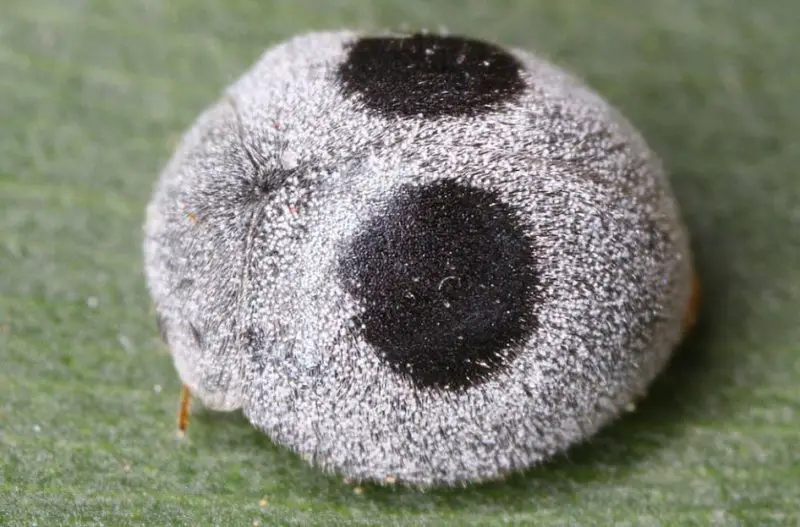
Azya luteipes, commonly known as white ladybugs, are frequently found on sweet orange leaves, where they play a crucial role in pest control. These ladybugs have a versatile diet, feeding on aphids and effectively combating various pest species, making them valuable allies in agriculture, particularly in coffee plantations.
Their appearance varies, with some individuals sporting a white body adorned with black spots, while others exhibit a brown body with two prominent black spots on the elytra. This diversity in coloration adds to their intrigue and makes them easily recognizable in their natural habitat.
Originating from South America, Azya luteipes has been widely imported and introduced to various regions around the world. Their effectiveness in controlling pest populations, coupled with their adaptability to different environments, has made them popular choices for biological pest control programs.
Small-Spotted Fairy Lady Beetle
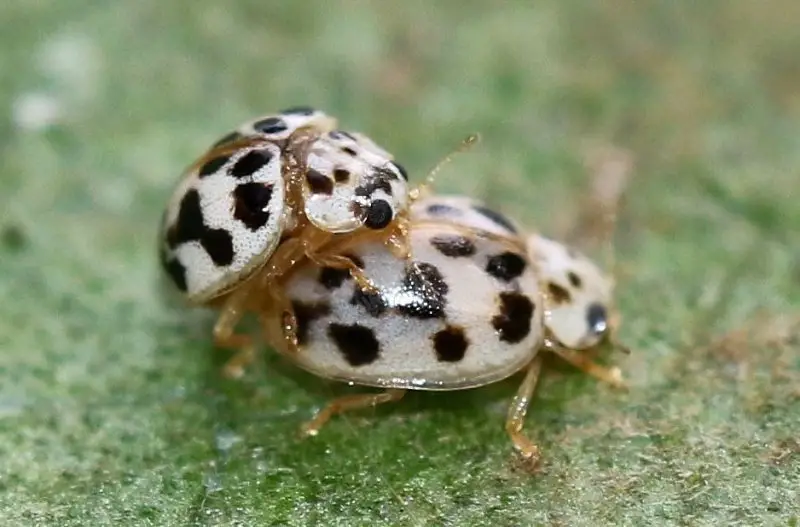
The Small-spotted Fairy Lady Beetle, scientifically known as Psyllobora parvinotata, is a diminutive yet distinct species known for its striking coloration. Typically, these lady beetles possess a completely white body adorned with black spots, a pattern that aids in their easy recognition. However, in some instances, the head of this species may deviate from the common white coloration to appear orange-brown, adding a touch of variability to their appearance.
Despite their small size, reaching a maximum length of only 3mm, Small-spotted Fairy Lady Beetles are quite common in the Southeastern United States. Particularly abundant populations of these beetles can be found in Florida, where they thrive in various habitats.
Their diminutive size and distinctive coloration make them easily distinguishable from other lady beetle species. The contrast of the white body with black spots or an orange-brown head sets them apart in the insect world.
Small-spotted Fairy Lady Beetles play a valuable role in the ecosystem by feeding on small insects and contributing to natural pest control. Their prevalence in certain regions, such as Florida, underscores their importance in local ecosystems and highlights the need for conservation efforts to ensure their continued presence and contribution to biodiversity.


